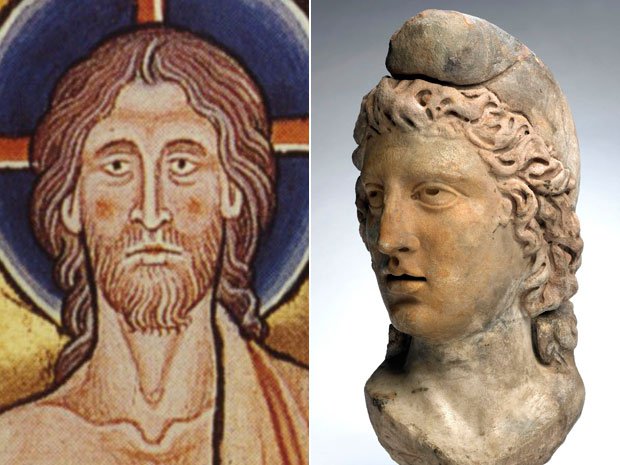 Submitted by Eyes Wide Shut on
Submitted by Eyes Wide Shut on

According to Martin A. Larson, in The Story of Christian Origins, Mithraism and Christianity derived from the same sources, originally from the savior cult of Osiris.
CONSIDER:
OSIRIS of EGYPT: He came to fulfill the law. Called "KRST," the "Anointed One." Born of the virgin Isis-Meri on December 25th in a cave / manger, with his birth announced by a star and attended by three wise men. Earthly father named "Seb" (translates to "Joseph.") At age 12 he was a child teacher in the Temple and at 30 he was baptized, having disappeared for 18 years. Osiris was baptized in the river Iarutana -- the river Jordan -- by "Anup the Baptizer," who was beheaded. (Anup translates to John.) He performed miracles, exorcised demons, raised El-Osiris from the dead. Walked on water and was betrayed by Typhon, crucified between two thieves on the 17th day of the month of Athyr. Buried in a tomb from which he arose on the third day (19th Athyr) and was resurrected. His suffering, death, and resurrection celebrated each year by His disciples on the Vernal Equinox -- Easter. Called "The Way, the Truth, the Light," "Messiah," "god's Anointed Son,' the "Son of Man," the "Word made Flesh," the "word of truth." Expected to reign a thousand years.
However, Larson believes that the Essenes were Jewish Pythagoreans, whose members not only gave birth to Christianity as Essenes, but were directly influenced by Zoroastrian doctrine as Pythagoreans. Mithraism, an established but exclusive sect devoted to social justice, was assimilated by state-sponsored Christianity before being disposed of in name.
Though no texts of Mithraism survive, various fragments, inscriptions and critical commentaries show that Mithraism and early Christianity both possess similar religious doctrines. The resemblances between the two churches were so striking as to impress even the minds of antiquity. From their common Zoroastrian sources, Mithraism first held that all souls pre-existed in the ethereal regions, and inhabited a body upon birth.
Life then becomes a great struggle between good and evil, spirit and body, the children of light versus the children of darkness (identical to Pythagoreanism). All souls were to be judged by Mithra (represented as a bull) with the Elect going to heaven, and the earthly and evil being annihilated in a great battle. Mithraism divided the human race into three classes: the spiritual Elect, the wicked, and those who try to be good but can't seem to overcome evil. The Elect go straight to heaven, while the good-intentioned wait until judgment to be resurrected, where the wicked will be destroyed.
Both Christianity and Mithraism prided themselves in brotherhood and organized their members as church congregations. Both religions purified themselves through baptism, and each participated in the same type of sacrament, bread and wine. Mithra was born in a cave; a cave is likewise the setting for the nativity of Jesus in the widely-read and influential Gospel of James, which though not canonical is the earliest surviving document attesting the veneration of Mary and claiming her continuing virginity. Both nativities were celebrated on December 25th, and each savior was visited by shepherds with gifts. Both Mithraism and Christianity considered Sunday their holy day, despite early Christianity observing the Jewish Sabbath for centuries. Many have noted that the title of Pope is found in Mithraic doctrine and seemingly prohibited in Christian doctrine. The words Peter (rock) and mass (sacrament) have original significance in Mithraism.
CONSIDER:
Hundreds of years before Jesus, according to the Mithraic religion, three Wise Men of Persia came to visit the baby savior-god Mithra, bring him gifts of gold, myrrh and frankincense.
Mithra was born on December 25 as told in the “Great Religions of the World”, page 330; “…it was the winter solstice celebrated by ancients as the birthday of Mithraism’s sun god”.
According to Mithraism, before Mithra died on a cross, he celebrated a “Last Supper with his twelve disciples, who represented the twelve signs of the zodiac.
After the death of Mithra, his body was laid to rest in a rock tomb.
Mithra had a celibate priesthood.
Mithra ascended into heaven during the spring (Passover) equinox (the time when the sun crosses the equator making night and day of equal length).
Both Mithraism and early Christianity considered abstinence, celibacy, and self-control to be among their highest virtues. Both had similar beliefs about the world, destiny, heaven and hell, and the immortality of the soul. Their conceptions of the battles between good and evil were almost identical, with Christianity adopting millennial epochs that were integral to Mithraism from Zoroastrianism. "They both admitted to the existence of a heaven inhabited by beautiful ones ... and a hell peopled by demons situate in the bowels of earth." (Cumont, 191) Both religions placed a flood at the beginning of history, and both believed in revelation as key to their doctrine. Both awaited the last judgment and resurrection of the dead after the final conflagration of the universe. Christ and Mithra were both referred to directly as the "Logos" (Larson 184).
It is probable that Christianity emphasized common features that attracted Mithra followers, perhaps the crucifix appealed to those Mithra followers who had crosses already branded on their foreheads. In art, the halo was a well-known depiction of Mithra, a true sun god, but which also depicts Christ in the same way. However, the similarities were an embarrassment, and differences such as star gazing were persecuted as heresy. Trypho wrote that "Justin Martyr declared that in a certain cave near Bethlehem ... Mary brought forth the Christ ... those who presided over the mysteries of Mithras were stirred up by the devil to say that in a place called among them a cave, they were initiated by them" (LXXVIII). Tertullian seems to have feared the parallels between Mithraism and Christianity the most, demonizing Mithraism as a perverted truth planted by the devil.
Sources:
- 1773 reads